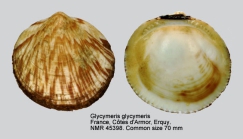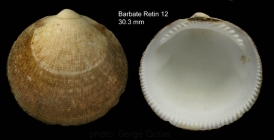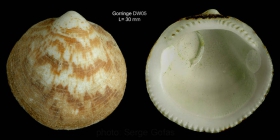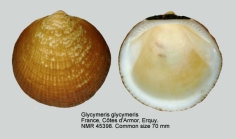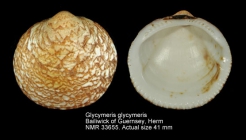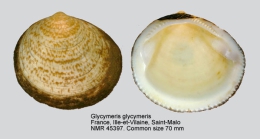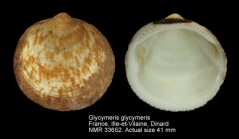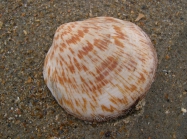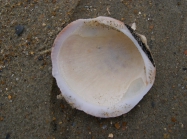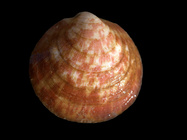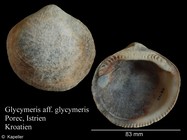Deep-Sea taxon details
Glycymeris glycymeris (Linnaeus, 1758)
140025 (urn:lsid:marinespecies.org:taxname:140025)
accepted
Species
marine
(of ) Linnaeus, C. (1758). Systema Naturae per regna tria naturae, secundum classes, ordines, genera, species, cum characteribus, differentiis, synonymis, locis. <em>Editio decima, reformata [10th revised edition], vol. 1: 824 pp. Laurentius Salvius: Holmiae.</em> , available online at https://biodiversitylibrary.org/page/726886
page(s): 695 [details] Available for editors
page(s): 695 [details] Available for editors
Note Guernsey, English Channel
From editor or global species database
Type locality Guernsey, English Channel [details]
Distribution Eastern Atlantic, from Norway to southern Morocco, also Canary Islands and Madeira. Gorringe seamount, moderately common in...
Distribution It is not known for sure if this species can be found at the Belgian coast.
Distribution Eastern Atlantic, from Norway to southern Morocco, also Canary Islands and Madeira. Gorringe seamount, moderately common in 96-180 m (deeper than along mainland coasts). [details]
Distribution It is not known for sure if this species can be found at the Belgian coast.
Distribution It is not known for sure if this species can be found at the Belgian coast. [details]
MolluscaBase eds. (2024). MolluscaBase. Glycymeris glycymeris (Linnaeus, 1758). Accessed through: Glover, A.G.; Higgs, N.; Horton, T. (2024) World Register of Deep-Sea species (WoRDSS) at: https://www.marinespecies.org/deepsea/aphia.php?p=taxdetails&id=140025 on 2024-04-23
Glover, A.G.; Higgs, N.; Horton, T. (2024). World Register of Deep-Sea species (WoRDSS). Glycymeris glycymeris (Linnaeus, 1758). Accessed at: https://marinespecies.org/deepsea/aphia.php?p=taxdetails&id=140025 on 2024-04-23
Date
action
by
original description
(of ) Linnaeus, C. (1758). Systema Naturae per regna tria naturae, secundum classes, ordines, genera, species, cum characteribus, differentiis, synonymis, locis. <em>Editio decima, reformata [10th revised edition], vol. 1: 824 pp. Laurentius Salvius: Holmiae.</em> , available online at https://biodiversitylibrary.org/page/726886
page(s): 695 [details] Available for editors
context source (BeRMS 2020) Bio-environmental research group; Institute of Agricultural and Fisheries research (ILVO), Belgium; (2015): Epibenthos and demersal fish monitoring data in function of wind energy development in the Belgian part of the North Sea. [details]
additional source Huber, M. (2010). <i>Compendium of bivalves. A full-color guide to 3,300 of the world's marine bivalves. A status on Bivalvia after 250 years of research</i>. Hackenheim: ConchBooks. 901 pp., 1 CD-ROM. (look up in IMIS) [details]
additional source Nolf F. & Swinnen F. (2013) The Glycymerididae (Mollusca: Bivalvia) of the NE Atlantic and the Mediterranean Sea. <i>Neptunea</i> 12(3): 1-35. [details]
additional source Purroy, A.; Šegvić-Bubić, T.; Holmes, A.; Bušelić, I.; Thébault, J.; Featherstone, A.; Peharda, M. (2016). Combined use of morphological and molecular tools to resolve species mis-Identifications in the Bivalvia. The case of <i>Glycymeris glycymeris</i> and <i>G. pilosa</i>. <em>PLoS One.</em> 11(9): e0162059., available online at https://doi.org/10.1371/journal.pone.0162059 [details]
page(s): 695 [details] Available for editors
context source (BeRMS 2020) Bio-environmental research group; Institute of Agricultural and Fisheries research (ILVO), Belgium; (2015): Epibenthos and demersal fish monitoring data in function of wind energy development in the Belgian part of the North Sea. [details]
additional source Huber, M. (2010). <i>Compendium of bivalves. A full-color guide to 3,300 of the world's marine bivalves. A status on Bivalvia after 250 years of research</i>. Hackenheim: ConchBooks. 901 pp., 1 CD-ROM. (look up in IMIS) [details]
additional source Nolf F. & Swinnen F. (2013) The Glycymerididae (Mollusca: Bivalvia) of the NE Atlantic and the Mediterranean Sea. <i>Neptunea</i> 12(3): 1-35. [details]
additional source Purroy, A.; Šegvić-Bubić, T.; Holmes, A.; Bušelić, I.; Thébault, J.; Featherstone, A.; Peharda, M. (2016). Combined use of morphological and molecular tools to resolve species mis-Identifications in the Bivalvia. The case of <i>Glycymeris glycymeris</i> and <i>G. pilosa</i>. <em>PLoS One.</em> 11(9): e0162059., available online at https://doi.org/10.1371/journal.pone.0162059 [details]
 Present
Present  Inaccurate
Inaccurate  Introduced: alien
Introduced: alien  Containing type locality
Containing type locality
From editor or global species database
Biology Type of larval development: not documented [inferred from prodissoconch morphology to be short planktonic, non-planktotrophic] [details]Diagnosis Shell large, up to 65 mm long, solid, equivalve, circular in shape and inflated, equilateral. Umbos situated on the vertical midline, very slightly prosogyrous, separated from the hinge line by a narrow triangular area covered by the ligament, which is dark brown. Sculpture of very fine comarginal cords and radial striae, giving a reticulated appearance under high magnification. Hinge wide and arched, taxodont, with no teeth under the umbo and between 6 and 12 teeth on each side. Exterior brown or yellowish, with irregular streaks of dark brown. Interior white, with a variable extension of brown patches. Periostracum more or less hairy, dark brown.
Glycymeris pilosa is a Mediterranean form with a stronger and densely hairy periostracum, considered by some authors as a distinct species, but could be an ecophenotype on more muddy bottoms.
[details]
Distribution Eastern Atlantic, from Norway to southern Morocco, also Canary Islands and Madeira. Gorringe seamount, moderately common in 96-180 m (deeper than along mainland coasts). [details]
Type locality Guernsey, English Channel [details]
From other sources
Distribution It is not known for sure if this species can be found at the Belgian coast. [details]Habitat Known from seamounts and knolls [details]
| Language | Name | |
|---|---|---|
| Albanian | bajame deti | [details] |
| Dutch | marmerschelpkamschelpgewone marmerschelp | [details] |
| English | orbicular arkdog-cockledog cocklecombshell | [details] |
| French | amande marbréeamande de mer | [details] |
| German | MeermandelMandelmuschelGemeine SamtmuschelEnglisches PastetchenArchenkammmuschel | [details] |
| Modern Greek (1453-) | Χοντραχιβάδα Ευρώπης | [details] |
| Portuguese | castanhola | [details] |
| Spanish | almendra de mar | [details] |
Encyclopedia of Marine Life of Britain and Ireland
Marine Life Information Network - UK
To Barcode of Life (26 barcodes)
To Biodiversity Heritage Library (27 publications)
To European Nucleotide Archive (ENA)
To GenBank (62 nucleotides; 26 proteins)
To Marine Bivalves of the British Isles webpage at National Museum of Wales
To PESI
To ITIS
Marine Life Information Network - UK
To Barcode of Life (26 barcodes)
To Biodiversity Heritage Library (27 publications)
To European Nucleotide Archive (ENA)
To GenBank (62 nucleotides; 26 proteins)
To Marine Bivalves of the British Isles webpage at National Museum of Wales
To PESI
To ITIS

